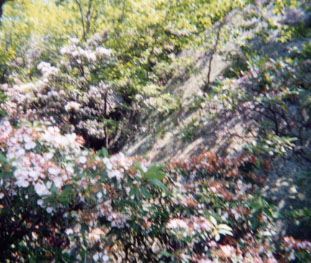


Firing your Workout: Food as Fuel
Since this is not a book about nutrition, I will only include what I do: I focus on what I should eat (fresh vegetables and fruit, whole grains, olive and nut oils, low-fat dairy products, protein powder and lean meats,) and drink (lots of water), and try to avoid what I shouldn’t, such as soda, processed pies, cakes, and cookies, ice cream, fatty, fried meats, alcohol, and junk food. I have enough bananas, whole grains and water to fuel my workout and enough lean protein afterwards to recover. To lose weight, I bulk up on enormous crunchy salads and protein powder so I have no energy to eat junk food. However, this advice is personal and anecdotal--I urge you to see a nutritionist for your needs.
Water is life, energy, flow, power, transportation, a lubricant, a skin smoother, an internal cleanser, and the miraculous force that fills empty spaces. Most people don't drink enough water, ever. However, I have occasionally had water intoxication during all-day endurance events when I consumed gallons of water without enough electrolytes.
Puke
Don’t eat rich, spicy foods just before you workout or you may puke. Bananas, Gatorade, and water are the best choices.
Benefits of Cardiorespiratory Exercise
When you sweat, huff and puff, so many great things happen to your body including an increase in circulation, VO2 max, aerobic capacity, stroke volume, cardiac output, oxygen transport, blood distribution, high-density lipoprotein, lung capacity. Your musculoskeletal system benefits by increasing bone density, lean muscle mass, functional strength and endurance, joint stability, and range of motion. Your neuromuscular system has increased reaction speed, sensory awareness, coordination, and balance. You can increase your basal metabolic rate, balance blood glucose leves, and increase the number of mitochondria in cells. And of course you look and feel great, save money on gas, and help in a tiny way to reduce pollution!
Measurement Miasma
In any endeavor, there are intrinsic and extrinsic results. You can measure the amount of weight lifted, the frequency, duration or intensity of exercise, your heart rate, your oxygen consumption, your body fat with calipers, your measurements, and your weight. Most of this is useful within limits. The problem is that quantitative measurement plateaus at a certain point or it becomes frustrating when impossible goals can’t be met. The intrinsic rewards of exercise are more important to me, such as self-expression, joy in movement, power, an exercise “high,” and an anger catharsis. These are some of the reasons people get involved in performance training, along with a desire to be part of a team, or to compete, excel, and win. Be aware of both quantitative and qualitative goals and results.
Be a Jive Jogger not a Gas Guzzler
In most of America, people are often judged by the kind of car they drive; in Manhattan, people are not only judged by their shoes, but are robbed and even killed for them. While this is also a tragedy, it at least shows where the focus should be--on your feet! In the interests of the planet, our foreign policy and our personal health, it is time to give up the addiction to cars. Try to walk or bike as much as possible, and use car pooling and public transportation when necessary, instead of riding alone in those SUVs.
Options for Walking as Transportation
During the New York transit strike of 2005 it seemed as if everyone was losing weight very fast, walking from the Bronx, Upper East Side, and Brooklyn into midtown Manhattan. Too much of this could be exhausting and injury-producing, but there are so many opportunities to get there faster by foot. Take them.
Walking to Socialize
Instead of sitting with friends at home, in a bar, or at Starbucks, why not go for a walk in the park, around the reservoir, or even to work? Create a social life that is good for your bodies as well as your relationships, sharing a love of people, nature and exercise together.
You have to be dressed for real-life aerobics. One reason you may not want to sweat is because you are overdressed in a fancy suit with heels or dress shoes. In fact, this may be what you wear every day. In that case, try to leave it near your desk at work and travel around in sneakers and a jogging outfit. You can wash up in the bathroom and bring deodorant and cologne. Don’t let fashion imprison you. Besides, with a healthier, stronger, leaner body you will look better in clothes anyway.
Shoes and Surfaces
Do you have a normal arch, a high arch, or a flat foot?
In Dr. Keefer's Corrective Clinic, we went over some of the injuries and conditions your feet can have. It’s all about cushioning and control: high-arched, stiff feet need cushioning and a lot of flexibility, while flat feet need control or support. Cushioning is related to shock absorption and dispersion. Before you begin walking or running everywhere, review your shoe repertory. No matter what, the toe box shouldn't cram your toes, the insole should support arch, and the heel counter should be well-padded. Your shoe salesman and/or podiatrist can help with your individual problems but make sure you continue to strengthen and stretch your feet as well, so that you don’t rely entirely on the shoe.
Surfaces
You may have been told that jogging on concrete is bad, although millions of people do it every day. Eventually that kind of relentless pounding will probably wear down your joints, unless coupled with excellent alignment, strength training, and cross-training with non-impact activities.
Walking on dirt paths is also easier than walking on concrete, but if the terrain is uneven then that requires some balance and accommodation. Walking in soft, dry sand is a real workout for the feet and calves and can be hard on the knees if you have cartilage degeneration.
How to Analyze and Improve Your Stride
Incorrect gait would be so loose your hips sway, or so stiff your joints almost freeze, with your stomach out or head forward. Walk smoothly with the head pulling you up to the sky so that your feet always have a soft landing.
A gait cycle, divided into the stance phase and the swing phase, is the time it takes for the heel of one foot to touch the ground again. The stance phase goes through heel strike, foot flat, heel-off, and then toe-off, except when you are sprinting. Swing phase is divided into early- or acceleration, mid- or swing through, and late- or deceleration. Gait analysis is a science of its own and any good podiatrist, orthopedist or neurologist will analyze your gait when diagnosing foot, ankle, knee and hip problems.
Stride length is determined by the distance from heel strike of one foot to the same foot in one cycle, while step length is determined by the heel strike of one foot to heel strike of the other in one gait cycle. The body's side-to-side movement is the stride width. I sometimes tell people to think of walking on a chalkline when their stride width is too wide. They never quite make the tightrope dancer look, but it helps to narrow the width. The pelvis tilts up and down and rotates around a horizontal axis in the transverse plane while walking and all the joints of the lower extremities are involved. As the pelvis rotates in one direction, the trunk rotates in the other, assisted by the swing momentum of the arms. In other words, walking uses every muscle in the body!
Ground reaction forces include a shearing force that is parallel to the ground, and an impact force that is perpendicular. The muscles that accelerate and decelerate your stride work with ground reaction forces when you are trying to compensate for weakness or injury.
Visual Cues
When walking in the city, look at your reflection in store windows to check your posture.
Kinesthetic Images
Head as a helium balloon, diamond necklace, long tail.
Front, Backwards, Sideways, On Your Toes, On Your Heels
Running differs from walking in that the speed may be 2 to 5.5 times greater, the stance phase is shortened, the swing phase is lengthened, there is no time of double support, and there is a nonsupport phase in which neither leg is weight bearing. Body weight, surfaces, shoes, speed, and where on the foot the runner lands all influence the impact peak forces. Softer surfaces can eliminate the impact peak. A good running shoe has a lower impact peak than a poorly constructed shoe.
Retro running is great if your trail is smooth and there is no one or nothing to crash into. Lift your feet and don’t trip.
Sideways stepping is okay but I will be recommending more effective lateral training with the Slide, aqua jogging, Knockout Ballet ‘n Box, and cross-country skiing.
However, walking on your toes or your heels for short periods on a flat surface is a good way to cross-train, test your balance, and improve the strength in your feet.
Puffball Huffs and Puffs
As a fat teenager, friends and family called me "Puffball." It is by huffing and puffing that you blow the extra fat off your house, or body structure. The most accurate way of assessing your cardiorespiratory progress is with a heart rate monitor. If you want to do it the old-fashioned way, I recommend that you take your RHR, or resting heart rate for three consecutive mornings while still lying down, but not right after the alarm has gone off or the cat has jumped on your head! The radial artery is the best place. If you are right-handed, locate the pulse on the thumb side of the left wrist, palm up. Place the index and middle finger, not the thumb, on the artery. Left-handed people can reverse wrists and hands. Count the number of beats for a full minute starting with zero. Add up the three mornings and divide by three to find your average. Average heart rates for sedentary population are 78-84 bpm for women and 72-78 bpm for men. A conditioned athlete’s heart will usually beat at 60bpm or less.
To get the most benefit from cardiorespiratory training, that is, reductions in blood pressure and/or decrease in body fat, you should work within your THRR or 40-85% of maximal oxygen consumption or 55-90% of maximal heart rate or MHR for 20-60 minutes or more, at least 3-5 days a week. Level I can get some benefit working at 40% of their MHR, and Level III may sometimes have to push over 85% if they are training for an event, flying to 92%, but only under supervision.
You can take a pulse during vigorous exercise but it isn’t always accurate. Five minutes after you begin aerobic work, and right after your most intense workout, see if you are working within your THRR. If this continues to interfere with your training, get a heart rate monitor. However, it is easier to measure your progress with your recovery pulse. After five minutes, the HR should be less than 55% of the estimated MHR or Maximal heart rate, 220 - your age.
Posture
Keep moving while taking your pulse to prevent lightheadedness, blood-pooling in the extremities, or unforeseen cardiac problems.
Heart Rates versus Borg Scale
You want to work at 55% to 85% of your maximal heart rate, which is 220 minus your age. However as you get older there are so many variables. You may be on medication, which would artificially increase or lower your heart rate. Your systolic or diastolic blood pressure may be low or high, and arrhythmias or heart disease could complicate the situation. Consult your cardiologist and wear a heart rate monitor to assure accuracy if there are problems. Beginners, people recovering from injury, and even endurance athletes may choose to work as low as 40% of your maximal heart rate if you are doing physical therapy exercises or marking a performance skill.
When you workout at a gym, you are surrounded by experienced trainers and instructors certified in CPR with defibrillators handy. When you workout at home, you are often alone, so please buy and wear a heart rate monitor. A stress test is recommended for all levels as well. If you think this is sissy stuff for Level I, realize that Lance Armstrong was hooked to a heart rate monitor 24 hours a day when training for the Tour de France.
Guidelines for the numbers: Recovery, endurance, 68 to 75, strength, 75 to 85, interval, 40 to 92, and race 85 to 92, within a so-called aerobic activity like biking, hiking, running or swimming. Some of these regulations dissuade elders who could just do it for the motion for a month, forgetting about trying to work in their training zone, especially if you are taking beta blockers, or have arrhythmias.
With the Borg scale, you simply measure your perceived exertion, either on a 10 or 20 point scale from very, very light to very very hard or heavy. If 1 is lying in bed, without a care in the world and 10 feels like you are running for your life, 7 is running for the last bus home. Do you want to workout between 6 and 8? Or is a 5 workout all you can handle after a sleepless night? Are you out of breath, sweaty, unable to talk? Sometimes people confuse a cardio workout with anxiety or joint pain, so perceived exertion is not always accurate. On the other hand, training numerically may sometimes cause you to ignore subtle kinesthetic signs of discomfort. The human body is more complex than any machine, and sometimes our senses warn us about hidden problems with the kidneys or other organs. The best method is to use a heart rate monitor as well as perceived exertion.
The Dyspnea scale is another subjective scale to measure how difficult it is to breathe, from mild, to moderate, to severe. This can be complicated by asthma, smoking, pollution, or extremely dry or humid weather conditions. But breathing is as important as heart rate--we are talking about cardiorespiratory fitness.
Performance
Increase speed and impact from a stroll, walk, trot, jog to a run. Obviously, speed gives the best performance results but a moderate pace is always safer, and may keep you going longer.
Sweating: Climate, Clothes, Condition, Catastrophe
After doing a lot of hiking in extreme heat and humidity, I realize the importance of balancing the electrolytes. Drink a lot of water, but if you start to shiver and feel nauseous and empty-headed, it's too much. You need electrolyte solutions, bananas, oranges, apricots and even salty foods if you are sweating excessively for a long time, particularly in hot weather.
Cardiorespiratory Training
Cardiorespiratory training should include techniques that focus on relaxation, recovery, endurance or steady state, cardio-strength training, interval, intermittent, circuit, and/or race training. This can be done with a variety of modalities from walking to running, climbing, cycling, skiing, kickboxing, or cardio-strength classes. You can also vary the program periodically, by switching the kinds of activities you do (periodization,) so you don’t get stuck in a rut. Exercise, like life, is a balance between the techniques you perfect through repetition, and the growth that occurs when you adapt to changes.
Relaxation and Recovery
Relaxation comes first, especially if you have a heart condition. Learn to let go of your muscles, to breathe diaphragmatically, to clear your mind, and lower your resting heart rate. Then you have a place to return to, the basement, should your heart rate feel like it’s flying off the top of the roof. Recovery has the pace and intensity you need when you begin and end, when you want to flush out lactic acid after an anaerobic sprint, when you are just getting in shape after an injury, or learning a new skill. It is also a mindbody technique that performance athletes use to slow down the heart and breathing and focus the mind before a big push to the finish. Everyone should work on this valuable technique. Your heart rate should stay below 65% of your maximal heart rate. You should feel relaxed, light, energized, happy. At times you could bring it down to that early morning sleepy pulse.
Endurance or Steady State
Actually the easiest way to start for Level I may be a submaximal steady state with occasional increases in intensity--just get out there and walk. But cardiorespiratory training does involve sweating, huffing and puffing enough to get into your target heart range.
Continuous or steady state training is visualized as a flat top bell curve where you gradually increase your intensity, hold it steady for ten to sixty minutes and then gradually decrease to a resting state. Just as it takes more energy for a rocket to lift off then orbit, it gradually becomes easy to maintain a steady state, almost as if you were floating. This technique is particularly useful for marathons or triathlons where you don't want to exhaust yourself.
Steady state can be a low bell curve or a steady climb.
Cardio-strength Training
You can take this into a steady climb by gradually increasing your pace and intensity after you are floating easily at one level. Keep climbing in intensity and then slow down gradually as well. Ideally you are working between 75% and 85% of your maximal heart rate when you combine cardiorespiratory training with strength endurance. You could do this running or walking up an incline, or hiking with a heavy pack. Make sure that your musculoskeletal system can handle whatever resistance you give it. This is the prefered zone for Knockout Step/Slide/Strike™
Performance
Effort is sustained, heavy, usually direct. Near the end of the interval, your muscles burn and you feel like you can’t go on.
Interval Training
Interval training is a combination of high intensity work approaching your anaerobic threshold where you feel you just can't go any faster or harder, followed by lower intensity active recovery where you still keep moving. For example, you could sprint as fast as possible for several minutes and then jog lightly or walk quickly for ten minutes. Bikers use this technique as they struggle up a steep hill and then coast down, race along a throughway, and then slow down in traffic. The work range can vary from 40% for Level I or a recovery phase, to 92% for Level III.
Intermittent training is a little more random and spontaneous, often related to other factors such as skill or choreography. A ballet dancer can do a difficult jump-and-turn variation for several minutes, and then stop, bourree and ripple her arms like a swan. A martial artist can go through a dazzling combination of kicks and punches and then bob and weave in the fighting stance.
Circuit training is most often seen at the health club when you move from machine to machine, but you can also do it at home in a boot camp class. Some parks combine walking and running with circuit training: you get to a circuit, do ten push-ups, sit-ups or stretches and then continue walking or jogging to the next one. It is a great way to keep your muscles limber, avoid boredom, and work the whole body.
Are You Working Too Hard?
What is your heart-rate? Your blood pressure?
If you are working too hard, slow down, go on flat surfaces, decrease your arm movements and stride, talk to friends, and look at the sights. Breathe slowly, deeply, and evenly. Hum, smile, sigh, and laugh. Check your heart-rate monitor before accelerating again.
Jogging and Running to Pop the Plateau
You can break into a light jog any time to vary your workout and increase your heart rate. You can also use different arm movements, elevating them over your head, to the side, in fact doing all the movements in the shoulder section faster and without weights. Of course you could look a little crazy doing this as you walk down a busy street. I use this technique, interspersed with kicks and punches, whenever I have to walk across Central Park alone at night. It works.
If you aren't working hard enough, increase your pace, go uphill, lengthen your stride, add dynamic arm movements, skip and hop on soft surfaces, or follow intricate patterns.
Level III athletes may want to push to their anaerobic threshold, so the talk test may not be appropriate. In this case, you want to huff, puff, sweat, and steam until you feel you can’t go any faster or further. However, you must respect your joints and muscles. Your weakest link is what gives under maximal exertion. If you have a race day where you go all out, make sure you rest and recover sufficiently.
Don’t Stop Suddenly!
Stopping suddenly can be problematic. Athletes and ballet dancers stop and start but still get a good cardiovascular workout. However, if you want to train your heart, it is good to stay at a steady state for 30 minutes or so to stabilize your heart at that effort level. If you have heart problems, it can be dangerous for you to stop suddenly.
Performance
If you are worried about your heart, use a light effort quality. Imagine your arms and legs floating over the ground like pieces of silk. Float through your training and stop gradually.
Cool-down
If you are a performance trainer, you may be saving all your energy for a triathlon, a kick-a-thon, a dance performance, a fight or a ballgame. Ballerinas generally hate to climb stairs. If this is the case, go ahead and take buses, subways and elevators. However, a leisurely walk can help flush the lactic acid out of the system and long stretches followed by meditation will complete this task as well as refresh you for the next workout.
We can always work on perfecting our stride. Even in the nursing home, walking is one of the most important activities.
Fall and Fail, Don’t Wail!
Kids fall all the time and laugh. As we get older, we are terrified of falling. In my Aerobic Gut and Butt™ program, I have an exercise called I’ve Fallen and I Can Get Up.
Barefoot Ballet Barre for Balance and Coordination
When people hear the word ballet they may think of graceful sylphs but they immediately say, “Ballerinas mutilate their bodies. By fifty, they can’t walk.” While this is true in many cases, it is because of overuse due to choreographic demands, lack of cross training, and insufficient rest and recovery. I plan to do some kind of ballet barre until I die because it is an excellent way of working from the ground up in an organized, methodical way that develops functional strength and flexibility, balance, coordination, focus, agility, movement efficiency and focus.
Ballet is made up of unstable positions on a stable surface while the Bosu, snowboarding, rough hiking and many circus techniques involve stable actions such as walking or squats and lunges on an unstable squishy, rocky or uneven surface. Prolonged aerobic activity in any unstable condition can damage joints as they struggle to get into alignment but some of these balance activities are essential to activate reflexes and strengthen core muscles.
Technique is the ability to do complex movement patterns without thinking too much, without emotion, an unconditional ability. To get this muscle memory one must rehearse and repeat familiar patterns like a ballet barre. However every person needs surprises and unexpected routines to get them out of their rut. So exercise should be some routine and some surprise, like everything else is life.

Gardening is a real workout. To lift, haul, dig, weed, till, plant, pull-out, and move pots and plants requires a strong structure of your own. In between soften arms and let them ripple like Swan Lake, balance, and do extensor and ab stretches.
Digging: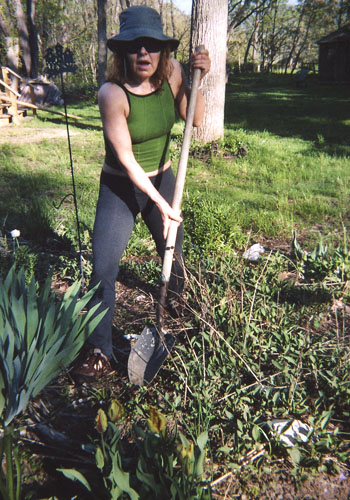 Keep the spine upright and the legs balanced in a lunge. Work from the lats.
Keep the spine upright and the legs balanced in a lunge. Work from the lats.
Planting: Don't stay in a deep squat for extended periods of time.
Weed Whacking: This is a strong, percussive effort, almost like martial arts training. Respect your weapon and yourself and take breaks to stretch.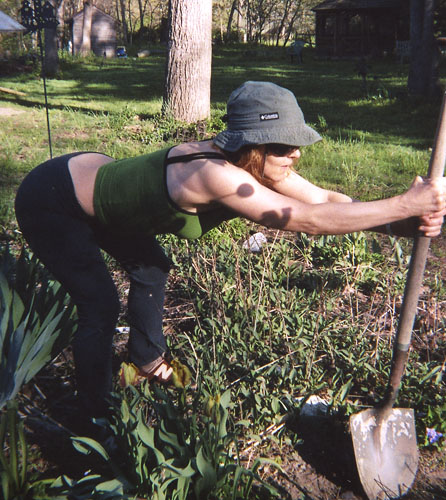
You can find ergonomic gardening tools at http://www.GardenWay.com. As we have stressed throughout this book, make sure you stretch before, during and after your gardening chores
Picnic Table Interludes to stretch the hip flexors off the table, the piriformis off the seat, and back extensor exercises.
Stretch your hamstrings, especially if you have been crumpled up all day. 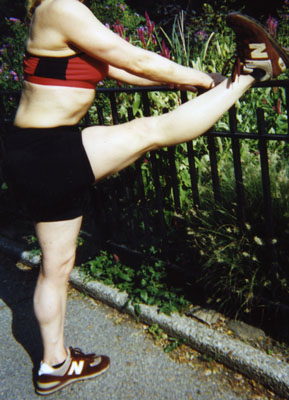
Balance on Logs to Activate Abs. TV Watching? On Your Stomach to Realign Spine at the end of the day.
Ch04: EvergreenEnergy
Meditation and introduction to the 12 energy centers of the
Principles of EvergreenEnergy™
EvergreenEnergy is a fluid stretch-and-tone class combining modern dance movements and floor work with some of the postures, breathing and meditation techniques of the ancient kundalini system. Unlike the other classes, it trains the cardiorespiratory system for relaxation and recovery so that you are better able to continue your hike, bike, ski, or swim with renewed energy. Ideally, you should use the EvergreenEnergy band, a more durable band designed for full body stretches, which you can put in your knapsack.
Stretch all Day
Most people put their lives into boxes, sitting, standing and walking in cramped positions all day, and then trying to stretch a few times a week at a yoga class. The best thing is to stretch all day, to keep the joints lubricated, and the muscles flexible. Then you are ready for anything.
Stretch Everywhere-Commune with Nature
Ideally, stretching should be done throughout the day in any location.
For example, you can stretch your calves while waiting for the bus, your quads while waiting for the bathroom, or your piriformis on the toilet. Stretching outside is a wonderful way to commune with nature. 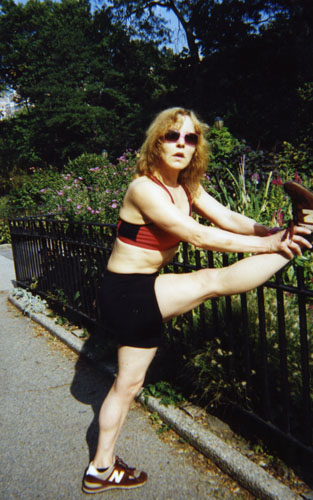
Pain
Muscles stretch better when they are warm after a few minutes of cardio. If you can’t do this, ease into your stretch fluidly, and don’t go to the end of your range right away.
The more flexible your body is, the better able you are to engage in strenuous athletic performance without injury.
Breathing, Meditation and Muscle Relaxation
For many people stretching is a painful activity, to be avoided, which is why yoga, with its emphasis on breathing and relaxation, has been so popular in America for the past forty years. But you can breathe and meditate every time you stretch. When you stop breathing you die, so it may seem strange when exercise instructors tell you to breathe. What I mean is that you should take full breaths, using the muscles of your abdomen and ribcage, not only to get more oxygen but to mobilize your core muscles.
Purr
Purr when a stretch starts to hurt and see if that helps. If not, back off until you feel comfortable.
Combine Stretching with Strengthening and Cardiovascular Training
Some people overdo the stretching, lying for hours in yoga classes, eschewing other types of exercise such as strengthening and cardiovascular training. Everything is important. You die of a heart attack, not tight muscles. Ballet dancers have the strength to hold up their stretches. Kickboxers use their strength and power through a complete range of motion.
Rejuvenation through a Flexible Mind and Body
A flexible body can lead to a flexible mind, the ability to flow, bend and adapt to stress, oozing into new ways of being. Flexibility can decrease with age with increased calcium deposits, dehydrated tissue, adhesions and more fibrous and fatty fibers instead of muscle. Mental flexibility also decreases when we encase ourselves in rigid thoughts and predictable ways of being. Allow yourself to grow at any age.
Stretching techniques and qualities
Stretches can be static or dynamic, active or passive, ballistic or PNF.
Time Elements
Static stretching means you hold a stretch without moving; ballistic means you bounce, bob, rebound or pulse while stretching; and dynamic means you stretch while moving as in grand battements in ballet or crescent kicks in martial arts.
If you feel pain while stretching, stop where you are, (don’t release suddenly or push the stretch further) and just imagine the muscles melting like hot butter.
PNF
PNF is the acronym for proprioceptive neuromuscular facilitation, a stretch, contract, release, reciprocal method of stretching to take advantage of agonist/antagonist stretch reflexes to exceed your habitual range of motion. This is assisted either by another person or a band.
Stretch/Strengthen
When you strengthen your muscles through the full range of motion, you are in fact stretching as well.
Active means you do it yourself; passive means you let someone or something, like a band or wall, stretch you.
Performance
Stretching can be done at different speeds with different movement qualities. Begin with a continuous fluid motion, overcurves and undercurves. Gradually slow down to longer stretches.
EvergreenEnergy is based on breath, the rhythm of the ebb and flow of gases in and out of your lungs. New age or classical music works as accompaniment as long as it isn't too percussive or dynamic. Opera and flutes work well. Here the emphasis is on fluid stretch-and-tone static stretch and strengthening. There is a free flow warm-up similar to modern dance which could be done on a waltz rhythm. There are two ways of doing this workout--as an intermittent stretch-and-tone throughout the day or on a wilderness adventure such as a long hike, or as a class. If the band is strong enough and attached at the right vantage point, it can provide significant strength training.
There are three sections to the class: 1) Free-flow movements similar to modern dance--full body bends, twists, spirals while standing, sitting, and lying prone and supine. 2) Stretch-and-tone movements with the EvergreenEnergy band (or light weights) similar to body sculpting. 3) Hypnomeditation while holding postures to open different energy centers. 4) Some way of plunging the body into deep relaxation.
EvergreenEnergy has 12 energy centers similar to ones in Eastern mindbody disciplines. We begin with the brown colors of the earth chakra near the coccyx and anus, connecting the legs to the earth. Then the yellow or water-colored center in the lower abdomen, the site of the sexual organs, is the center that increases physical and mental flexibility and weaves the body together with the passionate pulses of pleasure, plummeting it into periodic ecstasy. The orange center just below the navel coordinates the core muscles, and radiates ebullient joy and humor, laughing at yourself and the world to thwart potential anger or frustration. The red center above the navel is similar to the fire chakra, which heats up the mindbody, strengthens the physical body, and converts anger into ambition, will, and perseverance. The green rays of the heart center open the mindbody to love, aerobic energy and giving and receiving.
The 12 energy centers light up and energize the body. I can relax all my muscles instantly because of muscle memory from giving and receiving so many massages, and I can focus my brain with single-pointed meditation but none of this allows me to sink into a deep sleep. The combination of all those colors produces bright white light, a clean, healthy aura, but lights must be turned off to sleep. Sleep is about nestling into darkness, accepting your shadow, and whatever lies buried in your subconscious. Hypnosis is about control, and meditation about focus, but sleep is about letting go.
EE hypnomeditation
Crown
Seated Overcurves
Rainbow
Enlightenment
Brain
Headstand or modified
Pink sand
Wonder, imagination, intelligence, creativity
Eye
Muslim prayer position. Pose of a child
Indigo or deep violet
Focus
Nose
Breathing in the Sphinx
Silver
Smelling including youth/age
Mouth
Goldfish in the Cobra
Gold
Tasting including taste
Throat
Ripplinh arms as in Swan Lake, prone or seated
Blue
Communication--giving and taking
Upper chest and ribs
Cat's cradle improvisations
Green
Love
Solar plexus
Sit-ups
Red
Channelling anger into power
Below navel
Lower ab exercises
Orange
Humor and play
Near pubis
Open and close groin
Yellow
Sex and Flexibility
Tail to feet
Bridge or standing squat
Brown
Survival
Aura
The sum total of all energy centers
The light that energizes you but must be turned off to sleep
Shadow
Black or absence of light
Permits sleep
Unpredictable
Can be evil
Massage
Fire Red Invigorating
Solar Plexus--Power/Anger/Aggression some orange to stimulate detachment and humor
Shake, Hit, Vibrate, Loosen, Stimulate before or during an event or when tired, light up aura
Over some clothes
Ether Blue Soothing
Throat to fingers--Communication, giving and receiving
effleurage, fluid petrissage, lots of sweet smelling oil
Calm, organized, nail salon without the gossip, too fluid and light to be focused but could move to help let go into sleep
Naked skin
Green Heal/Repair
Heart --generous with the healing, open up as well
Painful but giving
Specific friction followed by drainage, or chest tapotement to stimulate breathing
Naked skin
Indigo Violet Focus and Balance with some earth to ground and help survive
Shiatsu
Nerve pressure points
Over clothes
Yellow Arouse, Integrate
Yellow Strong sensuous effleurage, petrissage, provocative friction moving through fire to the great release
Sequences
Fluid fifteen-minute warm-up followed by full body band stretches followed by static stretch holds and meditation/relaxation.
Posture
Stretching helps improve your posture. If your pecs are too tight, your shoulders will always be rounded.
Ch05: Mental/Spiritual
Focus on the earth, eye, and crown centers as you balance and open yourself to change and growth.
Ch06: Environmental: Be a Jive Jogger, Not a Gas Guzzler
Ways to use less gas and electricity to conserve energy as daylight increases.
Chart your normal use of gas and electricity on a monthly basis. Then walk more, turn off lights, and reward yourself when the bills go down with a trip to your favorite nature place. Make sure you hike when you get there instead of driving around. Come to the sultry, sizzling summer.